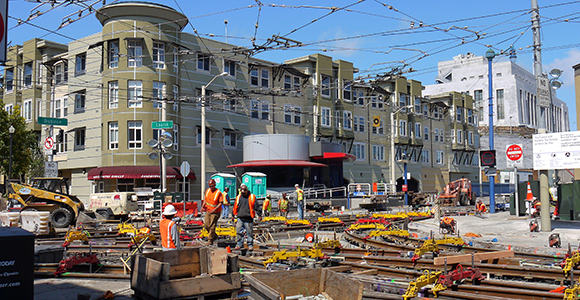
(Photo Credit: davitydave/Flickr)
Originally published on Capitol Weekly
They blew it. More than a year ago, Governor Brown called the Legislature into special session to find new ways to pay for the state’s aging transportation system.
A huge coalition—from highway and transit groups to trucking associations and business and labor organizations—asked the Legislature to put money into the system and improve accountability and results, citing clear benefits for jobs, economic development, and the environment.
Nothing happened.
Some hearings were held and a few tax proposals were considered, none on the scale needed to do the job. None were voted on, and the special session recessed last week with a whimper.
It’s time to move in a new direction—away from Sacramento’s political gridlock and toward a regional approach to governing and funding California’s transportation systems.
Until we do, it’s clear California’s deteriorating roads and aging transit systems will only get worse—continuing to be a drag on the economy. The Legislature focused this year on one part of the problem: the state’s $59 billion backlog in road maintenance. CA Fwd recently concluded that our transportation systems, from highways and bridges to airports and local roads, will require almost 10 times that much—$530 billion—to safely maintain and operate over the next 10 years. With the main source of state revenue—the gas tax—failing to keep pace with demand, public agencies have less than half the funds they need to pay for it. The state’s total transportation funding shortfall? Nearly $300 billion and climbing.
The source of this problem isn’t just funding or Sacramento politics: It’s an obsolete governance system—one that, for decades, funneled large amounts of federal money, matched with state dollars, to road, highway, and transit projects. With federal money drying up, state money is proving inadequate, and our leaders can’t seem to find innovative solutions.
While the state fiddles, local governments are taking action—and it’s at the local and regional level that the next generation of transportation solutions must be devised.
Taxpayers in 21 counties already pay for a sizable portion of their own transportation systems. These so-called “self-help” counties have approved $4 billion a year in local sales tax measures for everything from highway tunnels and transit extensions to local roads.
Those numbers are about to get a lot bigger.
Desperate to close growing funding gaps, four of the state’s biggest counties—Los Angeles, San Diego, Sacramento, and Santa Clara—will ask voters in November to approve nearly $150 billion in new tax measures—on top of existing taxes—over the next 30 years. These funds will go to everything from new transit (Santa Clara has earmarked $1.5 billion for extending BART into San Jose) to basic road repair (LA plans to spend $2.4 billion on maintenance alone). Six new counties are also poised to join the self-help ranks, with even conservative counties asking voters to raise taxes.
Let’s finally acknowledge what’s really happening: If state leaders are going to keep pushing more of this burden onto local governments, we need to give communities the tools to do the job.
We believe the time has come to develop a new relationship between the state and California’s economic regions—a new governance structure that will promote the kinds of transportation investments a growing population requires. If we are willing to consider policies that unleash the successful regional and county model—where voters even in tax-averse areas tend to support new transportation taxes when they see what they’re paying for—we could see a new generation of projects emerge, tailored to community needs.
The Brown administration has already laid the fiscal groundwork with its Enhanced Infrastructure Financing Districts, which will allow communities to combine private investments with a portion of the growth in their own economic development to finance transportation projects for years to come. These districts have the authority to capture the revenues—and other benefits—new infrastructure generates to pay for these investments. As communities fund more projects through public-private partnerships and performance-based financing, drivers and passengers will also have to contribute more through fees and usage charges, as will landowners and businesses that benefit from increased mobility.
This model will require a different role for the state, which should provide fiscal incentives to locals making investments that meet state goals while ensuring equity in regions lacking resources.
It won’t be easy to shift the transportation system away from California’s decades-long reliance on state funding, but it’s not impossible, either. It’s better than gridlock. And we believe its time is now.
—
Mark Pisano is chair of the Southwest Megaregion Alliance and former executive director of Southern California Association of Governments. Sean Randolph is senior director of the Bay Area Council Economic Institute

